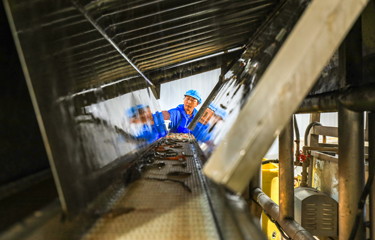Over two years on from the worldwide spread of Covid-19 and the subsequent lockdowns that started in March 2020, the seafood industry is still coming to grips with its varied consequences. Influence of the pandemic on the seafood processing and equipment sector can be seen in that category's top-read stories on SeafoodSource in 2022.
Despite Covid-19 continuing to have an influence on global supply chains as container prices and trade difficulties impacted seafood shipments and processing, the list also reflects broader changes in the landscape of seafood processing as the pandemic, geopolitical problems, and environmental concerns force companies to adapt.
Number 5: Container prices, port problems set to spike
Container price spikes, which had already jumped in 2021 due to Covid-19 delays, continued to be a challenge for much of 2022. Citywide lockdowns in Shanghai, one of China’s largest ports, also caused delays and cost increases throughout much of the year.
U.S. President Joe Biden, in a call with retailers in July 2022, cited high container prices as a cause of inflation in a call with retailers. Only nine companies ship freight from Asia to the U.S., and those companies had raised prices by as much as 1,000 percent.
In July, U.S. Congress passed the Ocean Shipping Reform Act, which the National Fisheries Institute called a “good start” toward holding shipping lines accountable and addressing backlogs in the U.S. seafood supply chain.
Number 4: US firms aim to “re-shore” seafood processing from China
Early in 2022, with logistical difficulties wreaking havor on U.S. seafood supply chains, some U.S. companies began to examine whether it would make sense to bring seafood processing back from China to the United States.
Through the summer of 2022, Chinese seafood processors were getting better returns selling to China's domestic market than export markets, and U.S. tariffs of up to 25 percent on seafood imported from China continued to squeeze margins. Portland, Maine, U.S.A.-based Bristol Seafood President and CEO Peter Handy told SeafoodSource that some U.S. buyers were finding it difficult to price China’s processing cost advantage – especially when some processing hubs were also dealing with sudden Covid-19-related shutdowns.
“Pricing is now complex to understand. To buy five loads out of China, I don’t know if anyone can quote [a price for] that,” Handy said. “Is it really inexpensive enough to operate in China to offset a 25 percent tariff, freight prices, and timing and the uncertainty about the plant’s operations?”
Number 3: Sole Ukraine exhibitor at Seafood Expo Global vows to rebuild
The first Seafood Expo Global since the start of Covid-19 – and the first time the trade show was held in Barcelona, Spain – was a sign of things returning to normal for most of the seafood world.
For Ukrainian companies, however, Russia’s invasion in February 2022 created more disarray and trouble. Every company that had planned to exhibit was forced to withdraw from the show – except for Kalynivka, Ukraine-based Ukrharchpromkomplex.
SeafoodSource spoke with Ukrharchpromkomplex General Manager Oleg Bilodid in his sparse booth at the show, which displayed only a logo and the flag of Ukraine. The company’s processing facility had been leveled weeks earlier by a Russian missile.
“The missile hit, and it’s destroyed,” Bilodid said at the show. “This is the missile, from Mr. Putin,” he added, pointing at an image of the missile contained in a folder full of photos showcasing the damage to the company’s facility – including photos of it on fire.
“Thank God nobody died, in both factories nobody died. That’s more important,” he said.
Number 2: Polystyrene bans and phase-outs pushing seafood packagers to seek alternatives
Environmental concerns about the impact of polystyrene foams and expanded polystyrene (EPS) – commonly known by the trademarked brand Styrofoam – is leading to bans on its continued use around the world.
EPS comes in a variety of forms, and its light weight, low cost, water resistance, and insulation ability all make it a staple of food packaging, especially in seafood. But a number of U.S. states are starting to ban its use, forcing companies to start looking for new options.
SeafoodSource spoke to Christa Biggs, the manager of business development for Aptar Food + Beverage’s food protection division. Aptar is one of the largest manufacturers of plastic products in the world, and Biggs said the company has seen demand grow for more-sustainable packaging.
“In terms of retail, and what I’ve seen from seafood customers a little more downstream, they are most focused on getting rid of that polystyrene foam from a sustainability standpoint,” Biggs said.
But Biggs said companies should understand it’s not always an easy changeover.
“It’s extremely complicated. It’s never just an easy switch,” she said.
Number 1: Report: China’s seafood demand overstated, with most imports processed and reexported
The most-read SeafoodSource processing and equipment story in 2022 was once again focused on processing in China.
A study by a joint U.S.-Norwegian group of academic economists and scientists titled, “China’s seafood imports – Not for domestic consumption?” suggested the country’s demand for seafood is overstated and that China’s reexports account for 75 percent of the country’s seafood imports.
The study also found that China’s seafood-processing sector, based on low cost and scale accounts, threatens the sustainability of the seafood industry elsewhere by facilitating mislabeling. The report found the huge scale of China’s operations could also provide cover for illegal, unreported, and unregulated (IUU) fishing.
“Exports [from China] as a share of combined imports and production exceed 100 percent for some higher-valued species such as cod and haddock, providing evidence of mislabeling,” it said. “A study of various species revealed, for example, that 57 percent and 39 percent of China’s Pacific salmon imports originate in the U.S. and Russia, respectively. This is crucial for seafood sustainability because the processing stage is an opportunity for seafood mislabeling with respect to country of origin and species.”
Photo courtesy of chinahbzyg/Shutterstock







